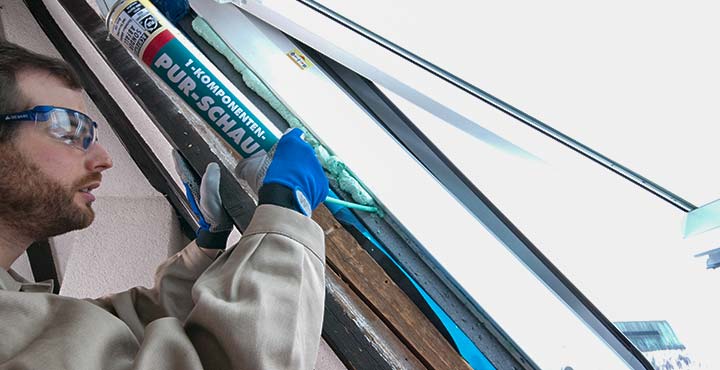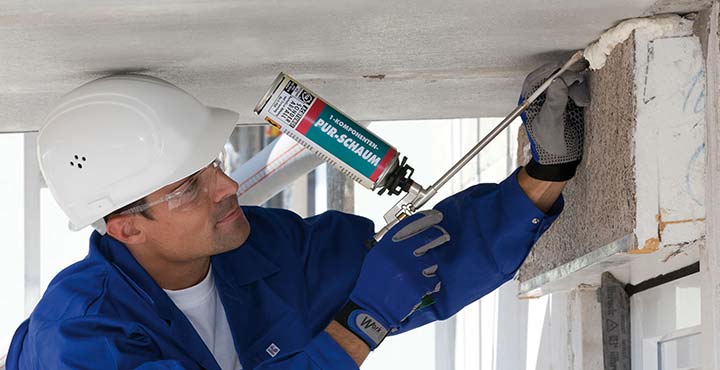
Working safely with PU
How to work safely with PU foam
Whatever tool you hold in your hands, it is important that you know how to use it. Hardened PU foam is resistant to mould and rotting, it has no odour and is physiologically safe. When working with foam, you should observe some basic safety instructions.
Wear protective clothing

PU foam adheres to almost every surface, even skin! The high adhesive quality of assembly foams is one of its greatest benefits for permanent insulation of windows and doors or sealing connections.
The effect you want on your building is something you need to avoid on your skin! Even very fresh foam is very sticky and can only be removed from the skin mechanically or with chemicals.
People who are sensitive could suffer irritation, if MDI foams come into direct contact with the skin and eyes. Therefore, you should display as little free skin as possible when working with PU foams, and wear gloves and goggles.
This protects the skin and the eyes in particular. If foams should get into the eyes, rinse immediately with plenty of water and seek medical advice.
Ensure that rooms are well ventilated

When working with foam, ensure that the workplace is ventilated adequately. Hardened PU foam is resistant to mould and rotting, it has no odour and is physiologically safe.
As long as the foam is not hardened, the vapours it emits are deemed harmful due to the isocyanates (MDI) it contains. Isocyanates, as a main constituent of assembly foams, can irritate e.g. eyes, skin and the respiratory passages.
The legislator has defined a maximum workplace concentration, the so-called MAK value, to protect people who work with PU foam on a regular basis. This value is 0.005 ppm and is not reached when the room is adequately ventilated, even if PU foams are used permanently.
An adequate air supply also ensures that no vapour-air mixes can be created with the pressurised gas of the aerosols that are highly flammable and explosive. Hardened construction foam contains no more free MDI and is therefore harmless. Measurements of room air close to hardened PU foam found that the values in the air lay below the detection limit.
Never heat up construction foam cans and protect them from the sun

Assembly foam cans are pressurised. Therefore, they may not be heated with lamps or fans, neither may they be placed on radiators because there is a risk of explosion. Likewise, the cans should be protected against direct sunlight and temperatures above 50 °C.
The reason? If a can is heated, the gas in the can may expand too quickly and increase the pressure in the can. In the worst case, the can may burst.
Very cold PU cans can be brought back up to a temperature at which they can be processed by placing them in lukewarm water. The better alternative would be to use winter foam.
PU winter foams are specially developed for frosty temperatures and, depending on the formula, deliver high-quality insulation and foaming results in temperatures up to -10 °C.
Never work with damaged cans
Even if a small dent seems harmless: the slightest of damage can weaken the can to the extent that it unable to withstand the pressure of the gas when used and explodes.
Here is some advice about storage and transportation of PU foam cans.
Avoid smoking and open flames
Like all aerosol cans, PU foam cans may not come into contact with fire. When working with cans, it is possible that vapour-air mixes can be created briefly that are highly flammable and explosive
Safety instructions on the can

The most important safety and health instructions are stated on each can. All chemical products sold in Europe need to be labelled according to the CLP Ordinance (Classification, Labelling and Packaging).
The CLP Ordinance replaces the previous national labelling regulations.
It is largely based on the recommendations by the United Nations, the GHS (Global Harmonised System for classification and labelling of chemicals). The objective of the global harmonised system is to make the level of protection for human safety and the environment standard, transparent and comparable.
We have summarised more information about the CLP ordinance and also provide explanations of the symbols on our website.
The general processing information stated here is not binding. For binding information about processing, handling and occupational safety, please refer to the product and safety data sheets for the respective PU foam issued by the manufacturer and the labels on the PU foam cans.
We also make reference to the coaching duty for expanding foam cans according to the European chemicals regulation REACH.
After 24 August 2023, trade and industry must have coached all their employees who work with PU foam. By order of the branch, the Association of the European Adhesive & Sealant Industry (FEICA) has prepared online coachings. The courses can be booked via the Feica homepage.
In addition, some manufacturers wish to make their own coaching offers for their customers. So it is worth inquiring with your own supplier. DIY people are not affected by this regulation.





